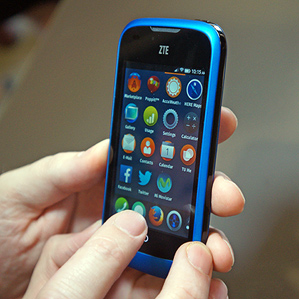First Firefox OS Device Will Cost $3 a Month
On Monday, Mozilla announced the rollout of the first smartphones running its Web-based Firefox OS. The devices are meant to appeal to first-time smartphone buyers who may find the latest iPhone or Android-powered handset out of their budget. But with modest hardware and an unproven operating system, it may be hard to break out of this niche.

Speaking to a small group of reporters at Mozilla’s San Francisco office on Monday, Brendan Eich, Mozilla’s chief technology officer (and the inventor of JavaScript), showed off the bright blue ZTE Open and orange Alcatel One Touch Fire. He said the ZTE Open will be available from the carrier Telefonica in Spain starting on Tuesday. It will cost 69 euros ($90) and include 30 euros of usage credit for prepaid users, as well as a four-gigabyte microSD card. For those who agree to a two-year contract, it will cost 2.38 euros ($3.11) per month. Eich also said that both devices will be available in Poland in several weeks.
Smartphones running Firefox OS will be available elsewhere—such as in South American countries—later this year. It is not clear when the devices will go on sale in the U.S., though Eich said he expects that to happen eventually.
Unlike Google’s Android OS and Apple’s iOS, Firefox OS relies heavily on Web-based apps. The presumption is that this will make it easier for developers to build apps that can work across multiple platforms, and for consumers to get their hands on a lower-cost, but still decent, smartphone (see “The Underdog Operating Systems Set to Shake Up the Smartphone Scene”).
“The Web is a rising tide around the world that everyone benefits from,” Eich said. “Firefox OS is just an instance of this new category of Web-based device.”
Mozilla has faced some security questions surrounding how it will keep malware off these devices, however. It is offering an app marketplace where users can download new apps, and also encouraging developers to make apps that can be downloaded from the Web or run via a website (see “Mozilla’s Mobile Firefox OS Raises Security Questions”).
The software, which has been in development for nearly two years, includes a simple user interface that is fairly similar to the iPhone’s on the surface, with rows of rounded app icons filling the home screen and a row of most-important apps (such as the phone dialer and Internet browser) across the bottom.
Eich cited Palm’s WebOS as an inspiration for Firefox OS, though he noted that Palm’s technology was a little early to market (the now-defunct WebOS was critically acclaimed, with features like multitasking that let the user flip through open apps as though they were a stack of cards; the devices that used the operating system didn’t catch on, though).
Facebook and Twitter apps will be preloaded onto the Firefox OS phones, and users can integrate their Facebook friends’ contact information into the phone’s address book. The phones include the Firefox Web browser, Nokia’s Here Maps app, and a simple camera app for shooting and lightly editing photos (both the Open and One Touch include a three-megapixel rear camera), and a Firefox Marketplace where users can download apps (including apps from major companies, such as AirBnB, Wikipedia, and Accuweather). A feature called adaptive app search allows users to search for something based on their intent, so if you search for “sushi,” the results will include various food-related apps like Yelp (for finding a sushi restaurant) or Epicurious (for finding a sushi recipe).
Both the handsets demoed by Mozilla today—the Alcatel One Touch Fire and the ZTE Open—felt light, with a touch screen that was bright but not high-end. I spent some time playing with the One Touch, finding the display quite responsive to touch and easy to navigate, though the screen could have been sharper. I noticed that graphics-heavy Web pages seemed to take a while to load, but I was told this was because the device was running off a mobile Wi-Fi hot spot, rather than a fixed network.
Eich stressed that Firefox OS is not “aiming high and crashing into Fortress Apple and Fortress Google.” Instead, he said, it’s an effort to bring feature-phone users to a “real Web smartphone” with lots of app choices.
Looking even farther ahead, he said, Mozilla is working to bring the Firefox OS to other mobile devices. “We went with smartphones first, but we’re going to get to tablets ASAP,” he said.
Keep Reading
Most Popular
Large language models can do jaw-dropping things. But nobody knows exactly why.
And that's a problem. Figuring it out is one of the biggest scientific puzzles of our time and a crucial step towards controlling more powerful future models.
The problem with plug-in hybrids? Their drivers.
Plug-in hybrids are often sold as a transition to EVs, but new data from Europe shows we’re still underestimating the emissions they produce.
Google DeepMind’s new generative model makes Super Mario–like games from scratch
Genie learns how to control games by watching hours and hours of video. It could help train next-gen robots too.
How scientists traced a mysterious covid case back to six toilets
When wastewater surveillance turns into a hunt for a single infected individual, the ethics get tricky.
Stay connected
Get the latest updates from
MIT Technology Review
Discover special offers, top stories, upcoming events, and more.